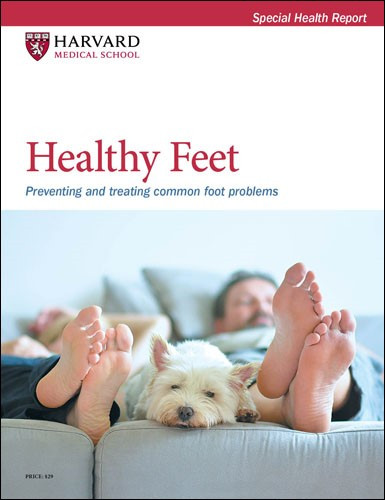Preparing your feet for summer
Strengthening the muscles in your feet and learning about pain relief fixes will help keep you active this summer.
- Reviewed by Anthony L. Komaroff, MD, Editor in Chief, Harvard Health Letter; Editorial Advisory Board Member, Harvard Health Publishing

Flip-flops, crop tops, and backyard barbecues: they're all signs of summer. Foot pain isn't a welcome part of that picture, but it will be a reality for many people in the coming season. "We often see people develop problems when they wear sandals or go barefoot, or when they increase their activities after being less active during the colder months," says Dr. Adam Tenforde, a sports medicine specialist at Harvard-affiliated Spaulding Rehabilitation Hospital. Fortunately, there's time to get your feet ready for the challenges that come with warm, sunny days and increased outdoor activities.
Prepare now
It's especially important to be proactive about foot pain if you've had a particular foot condition in the past or a risk factor such as obesity, diabetes, or thyroid disease. You may want to visit your foot doctor for a check-up. You can also consider the following steps.
Get the right equipment. This is the time to shop for shoes with the right support for your summer activities (most flip-flops don't fill the bill), whether it's playing sports, sightseeing, or standing for long periods. Look for shoes with large (or open) toe boxes that don't crowd the toes, laces or a backstrap to provide stability for the foot, and good arch support.
Seek physical therapy. A new trend in foot treatment strengthens the small muscles in the "foot core." "Just wearing supportive shoes won't make pain go away," Dr. Tenforde says. "A physical therapist trained in foot core strengthening can help you learn to engage the muscles in the feet, which will help to relieve tension in the ligaments." You can watch a video on foot core strengthening that Dr. Tenforde and his colleagues published in the Video Journal of Sports Medicine at /noms-hl.
Make a gradual change. If you want to wear sandals with less support than your regular shoes, or if you'll soon be walking barefoot on a beach, get your feet ready for the change. "Wear slightly less supportive shoes at home, and then shoes with even less support. This will give your feet time to adapt and get stronger," Dr. Tenforde says.
Common foot conditionsSummer activities often trigger or aggravate the following conditions. Plantar fasciitis. This condition, marked by sharp arch or heel pain, starts with tiny tears in the plantar fascia, a thick band of tissue that lies at the bottom of the foot and supports the arch. Achilles tendinitis. The Achilles tendon attaches to the heel. It can become irritated and cause pain and swelling in the heel behind your ankle. Sesamoiditis. The sesamoid bones are embedded in a tendon near the big toe. The bones and tendon can become inflamed and cause pain and swelling in the ball of the foot. Bunion irritation. A bunion is a deformity marked by a bump at the base of a misaligned big toe. The joint can become inflamed and painful. Arch irritation. People with fallen arches typically have weak tendons in the arch of the foot. Wearing shoes without arch support can cause pain in the arch area or heel. |
Learn some quick fixes
If foot pain does strike, address it as soon as possible to keep it from getting worse. The following remedies can provide fast, temporary relief.
Hot and cold therapy. Try this with foot baths. Fill one small basin with warm water and another with cool (not freezing) water. "Swirl your feet around in the warm water for 10 minutes. It will help open the blood vessels and promote blood flow, bringing nutrients to sore foot muscles. Then, swirl your feet in cool water for 10 minutes. That will make the blood vessels narrow and reduce inflammation and swelling," Dr. Tenforde says.
Topical medication. For foot pain and swelling, use a nonsteroidal anti-inflammatory drug (NSAID) in a topical form, such as diclofenac (Voltaren), which inhibits substances in the body that cause pain and inflammation. If you just have foot pain, try a cream or gel that contains either menthol or lidocaine, or both, which interrupt pain signals in the nerves. As with any medicine, creams with NSAIDs or lidocaine can cause side effects, so use only a little at a time, and get your doctor's okay first.
A foot massage. Massaging the feet helps improve circulation, stimulate muscles, reduce tension, and ease pain. You can get those effects by rolling your feet over a massage ball or foot roller. Or try massaging your feet with your hands and a little skin lotion or topical medication. If you have any circulation problems, talk to your doctor first to make sure this is safe.
Seek shockwave therapy. This therapy (about $100 to $250 per session) uses sound and pressure waves to heal injuries in the foot and ankle. "It's not covered by insurance," Dr. Tenforde says, "but treatment can help heal injuries and provide long-term pain relief from conditions such as plantar fasciitis."
Image: © VV-pics/Getty Images
About the Author

Heidi Godman, Executive Editor, Harvard Health Letter
About the Reviewer

Anthony L. Komaroff, MD, Editor in Chief, Harvard Health Letter; Editorial Advisory Board Member, Harvard Health Publishing
Disclaimer:
As a service to our readers, Harvard Health Publishing provides access to our library of archived content. Please note the date of last review or update on all articles.
No content on this site, regardless of date, should ever be used as a substitute for direct medical advice from your doctor or other qualified clinician.
















